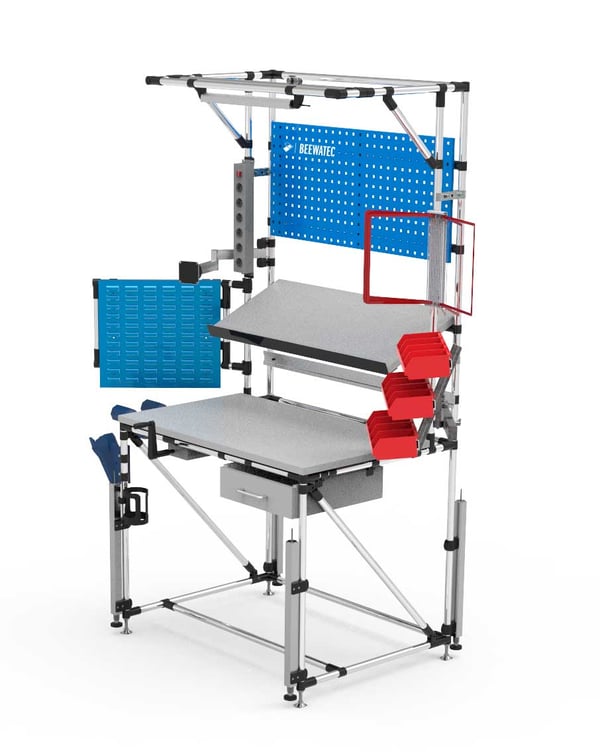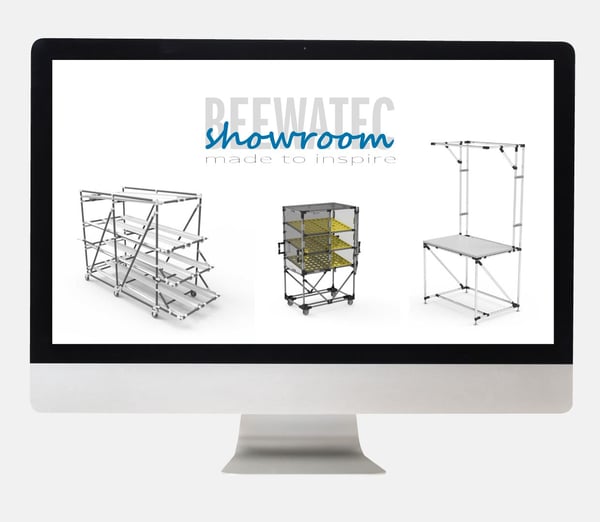Kaizen - Kaizen principle, Kaizen methods & importance for companies
In a world where markets are changing rapidly and competition is more intense than ever, organizations are looking for effective methods to remain...
Modular pipe systems
Attachments
5 min read
![]() Jens Walter
:
05.Februar.2024
Jens Walter
:
05.Februar.2024
In today's business world, efficient working plays a central role. One proven method for optimizing workplace organization is the 5S method. But what is behind this concept? In this blog article, we explain the basics of the 5S method in a simple and understandable way and show you examples of how you can use the methodology for your own success.
The 5S method is a lean management technique and is also used in the Toyota Production System (TPS). It aims to organize and optimize workplaces in order to improve safety, quality, productivity and efficiency while maintaining order and cleanliness. The term "5S" comes from five Japanese terms that represent the five steps of this method.rom five Japanese terms that represent the five steps of this method:

Seiri (sorting) - sorting out and removing everything that is unnecessary
Bei diesem Schritt wird alles Unnötige am Arbeitsplatz aussortiert und entfernt (z. B. Arbeitsmittel, Werkzeuge, Notizen und Memos, Müll usw.). Nur das Nötigste sollte aufbewahrt werden, um eine saubere und effiziente Umgebung zu schaffen.
Seiton (systematize) - (re)arrangement of all remaining things
The aim here is to arrange the remaining items so that they are within reach and within reach. A structured and well-organized workplace contributes to efficiency.
Seiso (cleaning) - Regular cleaning of the workplace
This step involves regular cleaning of the workplace to maintain a safe and pleasant environment. Cleanliness not only contributes to safety, but also to the identification of errors.
Seiketsu (standardization) - introducing (work) processes and standards
This is about developing standards and processes to maintain the results of the first three steps. Standardization helps to create clarity and consistency for workflows.
Shitsuke (self-discipline) - adherence to standards for continuous improvement
This step relates to compliance with the developed standards and continuous improvement. It is about accepting the changes as part of daily work practice and ensuring that the 5S principles are continuously applied.
Together, these five steps help to create a well-organized, safe and efficient workplace. The 5S method promotes a culture of continuous improvement (= Kaizen) and is an integral part of lean management.
The 5S method has a number of significant implications for companies, particularly in the areas of efficiency, productivity, quality management and occupational safety. Here are some specific aspects of the importance of the 5S method for companies:
Increased efficiency: by sorting out unneeded items (Seiri), systematically arranging them (Seiton) and standardizing work processes (Seiketsu), the work environment is optimized. This leads to a reduction in waste, shorter search times and an overall more efficient use of resources.
Cost savings: The 5S method aims to minimize waste, whether in the form of excess inventory, unnecessary transportation costs or wasted labor. By implementing the 5S method, companies can reduce costs and improve their profitability.
Quality improvement: Standardization (Seiketsu) helps to create consistent and reliable workflows. This helps to improve the quality of products or services, as standardization often goes hand in hand with clear quality standards.
Occupational safety: Regular cleaning (Seiso) and the systematic arrangement of items (Seiton) help to identify and eliminate potential hazards. A clean and organized workplace promotes employee safety and reduces the risk of accidents.
Employee involvement and motivation: The 5S method promotes the involvement of employees in the continuous improvement process. Employees are encouraged to actively participate in the implementation of the 5S principles and to contribute their ideas for improving the working environment. This can lead to increased employee motivation and satisfaction.
Customer orientation: By standardizing processes and improving quality, companies can work in a more customer-oriented manner. This can increase customer satisfaction and strengthen competitiveness. At the same time, deviations are recognized more quickly.
Continuous improvement: The 5S method lays the foundation for a culture of continuous improvement. By establishing the principles of 5S as a daily habit (shitsuke), companies can react more flexibly to changes and continue to develop.
The 5S method is often used as the basis for Kaizen. By implementing the principles of 5S (sort, systematize, clean, standardize, self-discipline), companies lay the foundation for an organized, clean and efficient work environment. This improved foundation then makes it easier to integrate Kaizen principles into daily operations.
Kaizen refers to the process of continuous improvement itself. It is a philosophy that aims to achieve small incremental improvements in all aspects of the business, be it in processes, products or employee performance. Kaizen encourages employees to actively make suggestions for improvement and to make small changes on a regular basis.
An ideal workplace optimized according to the 5S method would fully integrate the principles of sorting, systematization, cleaning, standardization and self-discipline. Here is a description of what this workplace might look like:
Sorting (Seiri):
Systematize (Seiton):

BeeWaTec contributes to the implementation of the 5S method by providing hardware and expertise. Lean solutions such as workstation systems or cleaning trolleys made from a tubular plug-in system are particularly suitable for remaining adaptable and firmly anchoring the aspects of the 5S method in the company.
Adaptability (flexibility): Flexible workstations make it possible to easily adapt the physical environment to changing requirements. This is particularly important in the context of Seiri (sorting), as work requirements can change. The ability to quickly adapt the workplace to new conditions makes it easier to implement new requirements.
Efficient use of space: With the help of the Beewatec modular system, a flexible workstation design is made possible, enabling a more efficient use of the available space. This is particularly important in order to design the workplace in such a way that all necessary items are easily accessible (Seiton), while also taking basic aspects of health and ergonomics into account.
Encourage employee involvement (self-discipline): BeeWaTec enables employees to individually design and customize their own workplace, which promotes self-discipline. Integrating employees into the process of workplace design and optimization increases the likelihood that the 5S principles will be continuously adhered to and even further promoted.
Integration of technology: BeeWaTec also facilitates the integration of new technologies through flexibly configurable workstations.
The 5S method offers a structured approach to improving organization, efficiency and safety in the workplace. By sorting, systematizing, cleaning, standardizing and self-discipline, companies can reduce waste, establish quality standards and promote a positive work culture. The 5S method is not only a tool to increase efficiency, but also a way to promote continuous improvement and optimize a company's overall performance.

With our modular system you can implement any solution you need. Discover your possibilities, existing solutions or build your own material flow system with BEEVisio in 3D.
In a world where markets are changing rapidly and competition is more intense than ever, organizations are looking for effective methods to remain...
At a time when companies are striving to increase efficiency and cut costs, the concept of lean management has established itself as a highly...
The material flow is an important part of every production and logistics. It describes the physical movement of materials, products and goods through...